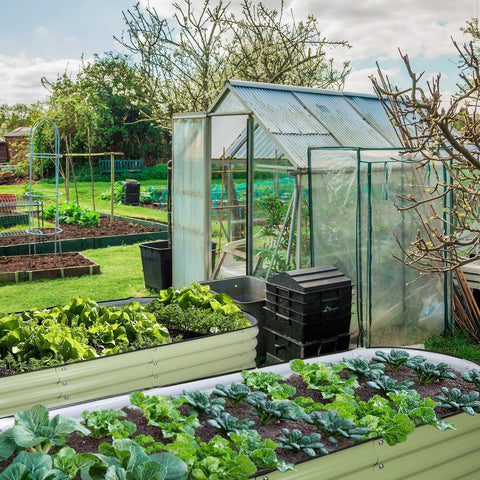8 Tips for Growing Morning Glory in Garden Beds
Discover eight delightful tips that will help you successfully grow morning glory in your garden!The following content also has some reference value for raised garden beds.
Morning glory (Ipomoea tricolor, I. purpurea) is a classic flower that welcomes delightful birds and butterflies to your garden. These delicate flowers can paint your garden in shades of pink, purple, and red. They are annual flowers that bloom in zones 2 to 11, so you'll need to replant them every year to enjoy their charming blooms.
Growing morning glory in garden beds is an excellent way to enhance your yard, balcony, or backyard. Learn these eight tips for planting morning glory in garden beds so that you can enjoy a stunning garden!
1.Choose the Perfect Garden Bed
Morning glory prefers containers with a diameter of 10 to 12 inches and a depth of about 6 inches. Look for containers with drainage holes at the bottom as they prefer well-draining soil. Choosing a bottomless Olle metal garden bed is a good first step.
2.Select Your Potting Mix
Morning glory thrives in moist but not soggy soil. Promoting good drainage in the potting mix can help you maintain consistent moisture for your morning glory. Adding peat moss to the potting soil can alter its texture and improve drainage. Mix equal parts of peat moss, sand, and potting mix together to keep your flowers happy.
3.Extend a Helping Hand before Sowing Morning Glory Seeds in the Potting Soil
On the evening before planting your morning glory seeds in the potting soil, lend a helping hand. Fill a bowl or glass with warm water and place the seeds in it to promote germination. Soaking the seeds overnight will soften the hard parts of the outer shell and may even trigger a small root to emerge! Essentially, soaking them for up to 24 hours can give your morning glory a head start before planting.
4.Provide Support
Morning glory is a vine, so it needs support as it begins to grow. Plan ahead and place a support structure or trellis next to the flower pot so that it can climb. It's usually best to do this before sowing to avoid disturbing the roots once the plant is established.
Morning glory can grow up to 10 feet tall! So, having support in place beforehand will help ensure your plant has what it needs to grow tall and strong.
5.Sow Your Seeds
After soaking your seeds, it's time to start planting! Aim to plant your seeds indoors about 4 to 6 weeks before the last spring frost. Keep temperatures between 65 and 85 degrees Fahrenheit to help them germinate. Then, place them on the surface of the soil and tuck them in with a light ¼ inch of your potting mix as a blanket. You should see sprouts poking up through the soil in about seven days.
Note: Morning glory seeds are toxic, so it's best to keep them away from children and pets.
6.Find an Ideal Location
Ideally, look for an area that receives at least six hours of sunlight each day. Ample sunlight will help them produce their best and most vibrant flowers. Then, choose a location without strong winds. Gusts of wind can damage the vines growing on trellises. So, be mindful of a sunny spot that has some wind protection from trees or nearby structures.
7.Provide Adequate Water
Water is a basic care requirement for morning glory. Water your plants at least twice a week to keep the soil moist. For best practice, feel the top inch of soil daily to gauge its dryness. In hot weather, garden beds can dry out quickly, and you may need to water daily or every other day. You can also add a 1 to 2-inch layer of mulch on top of the flower bed to help retain moisture.
Pro Tip: If your plants are wilting and the soil is dry, you may be under-watering. Assess the topsoil's moisture and adjust your watering routine. Alternatively, if the leaves turn yellow and the soil is damp, it may be over-watering. Wait until the top layer of soil is dry before watering again.
8.Avoid Invasive Field Bindweed
Morning glory can easily be mistaken for field bindweed (Convolvulus arvensis). Field bindweed also commonly goes by the names perennial morning glory and creeping jenny.
Field bindweed is an invasive plant species with roots and rhizomes that grow deep in the soil, making it challenging to eradicate.
To check if your plants are field bindweed, look for the following characteristics:
- Leaves smaller than 2 inches
- Plants with flowers in only pink and white colors
- Thin vines without small hairs
To control bindweed without using herbicides, cover the area where the plant is with cardboard or opaque polyester landscape fabric. Essentially, the cover needs to block any light from reaching the plant fully. Then, you'll need to have patience as the weed may take three to five years to die off due to insufficient light.
Wonderful Morning Glory
Planting morning glory in garden beds is a rewarding endeavor that will elevate your garden with stunning flowers and beautiful green foliage. By following key tips such as choosing the right garden bed, soaking seeds overnight, and selecting a sunny location, you can help your plants thrive! Just remember to watch out for plants that look like morning glory but may be invasive field bindweed.


